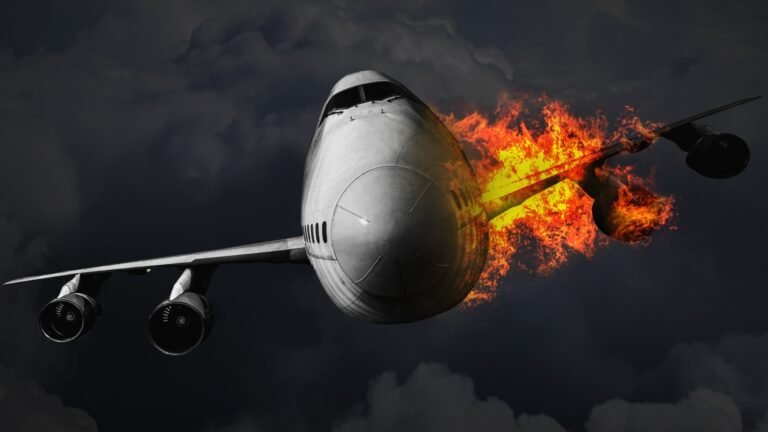How Does An Airplane’s Black Box Survive During Violent Crashes?
Photos For You/Getty
There are usually a lot of questions when a plane crashes. And the one thing that can help provide some much-needed context is the black box. Interestingly, an airplane’s black box isn’t really black, and it’s not just a box. It’s actually a pair of bright orange recording devices: the Cockpit Voice Recorder (CVR) and the Flight Data Recorder (FDR). Together, these systems preserve the last two hours of sound in the cockpit and at least 25 hours of flight performance data.
This information helps us understand how and why a plane crash occurred. On the one hand, that insight can be used to improve the design of planes and the training pilots receive. On the other hand, it helps displace public fear. Flight 587 is a good example. Just two months after 9/11, the aircraft broke apart minutes after departing JFK. The timing alone was enough to stir national panic. But within days, investigators were able to rule out terrorism through hard data retrieved from the black box. What had actually happened was that the aircraft had encountered some turbulence, and the co-pilot, in an attempt to stabilize the plane, had put too much pressure on the rudder.
This is what black boxes are designed to do. They preserve the sequence of events as they happened; details that might otherwise be lost to fire, extreme pressure, or the sea forever. But what’s even more interesting is how this device, often smaller than a microwave, is able to survive conditions that many other parts of the aircraft simply cannot.
Black boxes are engineered to endure the worst
Alexlmx/Getty
If you run through some of the worst accidents in aviation history, you’ll quickly realize just how violent plane crashes can be. As a result, black boxes are deliberately designed to survive worst-case scenarios. So, at the core of each unit is a Crash-Survivable Memory Module (CSMU), which contains a stack of memory boards where flight data is stored. This module is protected by three distinct layers. Closest to the memory cards is a slim aluminum housing, wrapped in a 1 inch layer of high-temperature silica insulation. The outer shell is typically made from either stainless steel or titanium.
Furthermore, each black box must meet the standards outlined in EUROCAE ED-112A, the international benchmark for crash-resistant flight recorders. That means surviving an impact of 3,400 g-forces, withstanding temperatures of 2,000 degrees Fahrenheit for at least an hour, and enduring 5,000 psi of crush force across six axes. But it doesn’t end there; it must also endure being submerged in saltwater for 30 days or being exposed to pressures found 20,000 feet underwater.
To achieve this, manufacturers run multiple, rigorous simulations, including firing units from air cannons and cooking them in propane fireballs. They then verify that all the preloaded data remains intact after the ordeal. Even if the outer casing is warped or burned, as long as the CSMU survives, so does the data. For example, when Air France Flight 447 disappeared over the Atlantic in 2009, it took almost two years to recover the black box from a depth of 13,000 feet. But when it was finally brought to the surface, the memory was still intact.
What good is a crash-proof recorder if no one finds it?
Artem Bruk/Shutterstock
Black boxes are designed to be durable, but they’re not perfect. Sometimes they remain missing for years. And if no one finds them, all that data’s lost. Ideally, each black box is equipped with a beacon that emits a ping once per second for 30 days. The signal travels more than 14,000 feet, guiding search teams to its location. But that only works if you’re searching in the right place. And in some cases, high-impact forces can knock the beacon off entirely. When Malaysia Airlines Flight MH370 disappeared in 2014, search crews spent years combing the Indian Ocean. But the black box was never found. That failure exposed the limits of a system that stores flight data locally. If the box disappears, so does the data.
In response, experts have pushed for real-time flight data streaming. Basically, a system that would beam key metrics to satellites or ground stations during the flight. The International Civil Aviation Organization ICAO recommended in 2016 that aircraft report their positions every 15 minutes, and more frequently in distress. While companies like FLYHT Aerospace and Aireon are already building the infrastructure, industry-wide adoption has been slow, mostly because of cost, privacy concerns, and a general reluctance to overhaul decades-old systems.
There’s also been growing interest in self-ejecting black boxes that launch clear of the wreckage on impact. These deployable recorders are easier to locate and less likely to be destroyed. Since 2002, some U.S. lawmakers have backed a bill requiring them; however, it hasn’t passed into law yet. At the end of the day, even with how relatively uncommon plane crashes are today, the worst-case scenario isn’t that the recorder gets destroyed. It’s that it survives, but no one ever recovers it.

